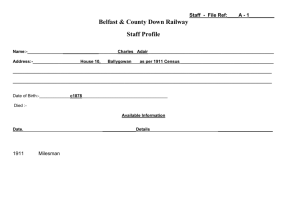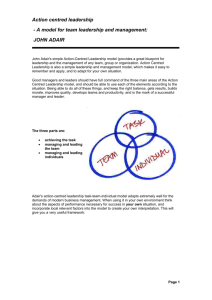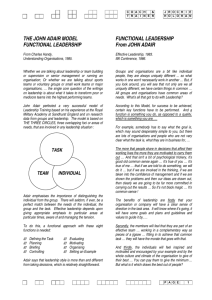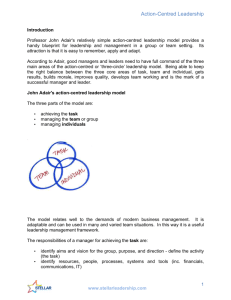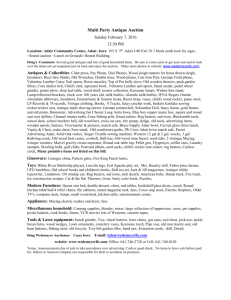Action Centred Leadership: John Adair's Model
advertisement
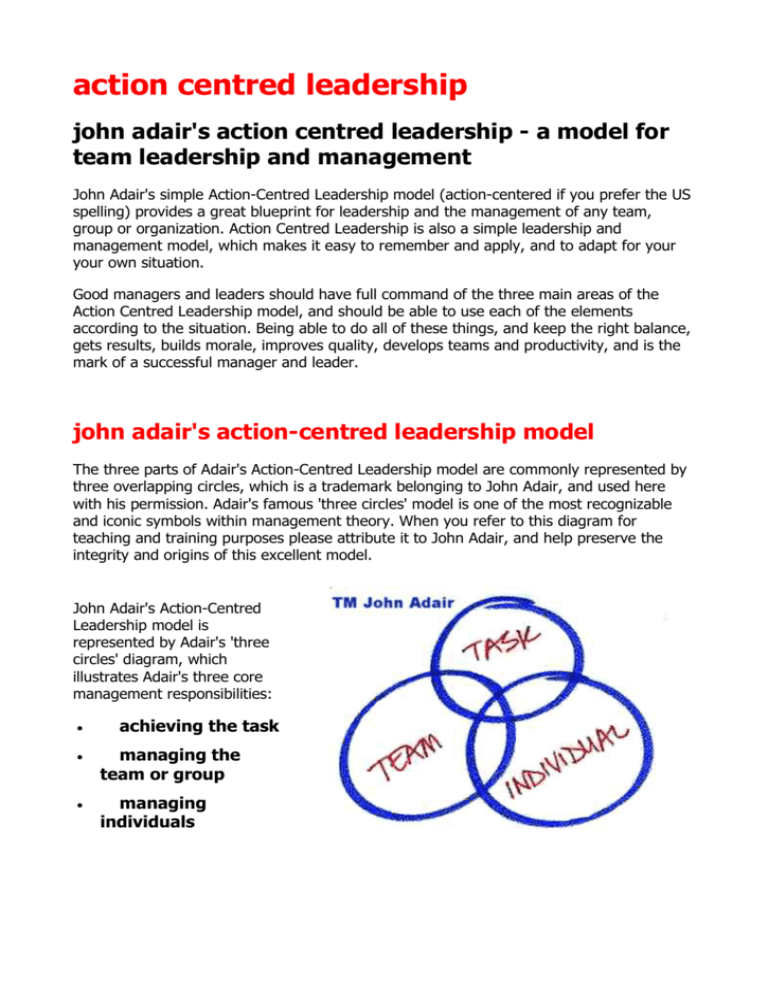
action centred leadership john adair's action centred leadership - a model for team leadership and management John Adair's simple Action-Centred Leadership model (action-centered if you prefer the US spelling) provides a great blueprint for leadership and the management of any team, group or organization. Action Centred Leadership is also a simple leadership and management model, which makes it easy to remember and apply, and to adapt for your your own situation. Good managers and leaders should have full command of the three main areas of the Action Centred Leadership model, and should be able to use each of the elements according to the situation. Being able to do all of these things, and keep the right balance, gets results, builds morale, improves quality, develops teams and productivity, and is the mark of a successful manager and leader. john adair's action-centred leadership model The three parts of Adair's Action-Centred Leadership model are commonly represented by three overlapping circles, which is a trademark belonging to John Adair, and used here with his permission. Adair's famous 'three circles' model is one of the most recognizable and iconic symbols within management theory. When you refer to this diagram for teaching and training purposes please attribute it to John Adair, and help preserve the integrity and origins of this excellent model. John Adair's Action-Centred Leadership model is represented by Adair's 'three circles' diagram, which illustrates Adair's three core management responsibilities: achieving the task managing the team or group managing individuals John Adair's action-centred leadership task-team-individual model adapts extremely well (as below) for the demands of modern business management. When using it in your own environment think about the aspects of performance necessary for success in your own situation, and incorporate local relevant factors into the model to create your own interpretation. This will give you a very useful management framework: your responsibilities as a manager for achieving the task are: identify aims and vision for the group, purpose, and direction - define the activity (the task) identify resources, people, processes, systems and tools (inc. financials, communications, IT) create the plan to achieve the task - deliverables, measures, timescales, strategy and tactics establish responsibilities, objectives, accountabilities and measures, by agreement and delegation set standards, quality, time and reporting parameters control and maintain activities against parameters monitor and maintain overall performance against plan report on progress towards the group's aim review, re-assess, adjust plan, methods and targets as necessary your responsibilities as a manager for the group are: establish, agree and communicate standards of performance and behaviour establish style, culture, approach of the group - soft skill elements monitor and maintain discipline, ethics, integrity and focus on objectives anticipate and resolve group conflict, struggles or disagreements assess and change as necessary the balance and composition of the group develop team-working, cooperation, morale and team-spirit develop the collective maturity and capability of the group - progressively increase group freedom and authority encourage the team towards objectives and aims - motivate the group and provide a collective sense of purpose identify, develop and agree team- and project-leadership roles within group enable, facilitate and ensure effective internal and external group communications identify and meet group training needs give feedback to the group on overall progress; consult with, and seek feedback and input from the group your responsibilities as a manager for each individual are: understand the team members as individuals - personality, skills, strengths, needs, aims and fears assist and support individuals - plans, problems, challenges, highs and lows identify and agree appropriate individual responsibilities and objectives give recognition and praise to individuals - acknowledge effort and good work where appropriate reward individuals with extra responsibility, advancement and status identify, develop and utilise each individual's capabilities and strengths train and develop individual team members develop individual freedom and authority action centred leadership and john adair John Adair, born 1934, British, developed his Action Centred Leadership model while lecturing at Sandhurst Royal Military Academy and as assistant director and head of leadership department at The Industrial Society. This would have been during the 1960's and 70's, so in terms of management theories, Adair's works is relatively recent. His work certainly encompasses and endorses much of the previous thinking on human needs and motivation by Maslow, Herzberg and Fayol, and his theory adds an elegant and simple additional organisational dimension to these earlier works. Very importantly, Adair was probably the first to demonstrate that leadership is a trainable, transferable skill, rather than it being an exclusively inborn ability. He helped change perception of management to encompass leadership, to include associated abilities of decision-making, communication and time-management. As well as developing the Action Centred Leadership model, Adair wrote over 40 books on management and leadership, including Effective Leadership, Not Bosses but Leaders, and Great Leaders. Adair is now a management consultant and also has his own publishing company in Surrey, England. He also maintains links with the University of Surrey, where he was the first UK chair of leadership studies, 1979-83. The John Adair Leadership Foundation appointed Dr David Farady as its director in January 2006. Carol Kennedy's excellent book 'Guide to the Management Gurus' supports the view that John Adair's ideas are fundamental and very significant in the development of management and leadership thinking: Leadership is different to management. All leaders are not necessarily great managers, but the best leaders leaders will possess good management skills. One skill-set does not automatically imply the other will be present. Adair used the original word meanings to emphasise this: Leadership is an ancient ability about deciding direction, from an Anglo-Saxon word meaning the road or path ahead; knowing the next step and then taking others with you to it. Managing is a later concept, from Latin 'manus', meaning hand, and more associated with handling a system or machine of some kind. The original concept of managing began in the 19th century when engineers and accountants started to become entrepreneurs. There are valuable elements of management not necessarily found in leadership, eg administration and managing resources. Leadership on the other hand contains elements not necessarily found in management, eg, inspiring others through the leader's own enthusiasm and commitment. The Action Centred Leadership model is Adair's best known work, in which the three elements - Achieving the Task, Developing the Team and Developing Individuals - are mutually dependent, as well as being separately essential to the overall leadership role. Importantly as well, Adair set out these core functions of leadership and says they are vital to the Action Centered Leadership model: Planning - seeking information, defining tasks, setting aims Initiating - briefing, task allocation, setting standards Controlling - maintaining standards, ensuring progress, ongoing decision-making Supporting - individuals' contributions, encouraging, team spirit, reconciling, morale Informing - clarifying tasks and plans, updating, receiving feedback and interpreting Evaluating - feasibility of ideas, performance, enabling self assessment The Action Centred Leadership model therefore does not stand alone, it must be part of an integrated approach to managing and leading, and also which should include a strong emphasis on applying these principles through training. Adair also promotes a '50:50 rule' which he applies to various situations involving two possible influencers, eg the view that 50% of motivation lies with the individual and 50% comes from external factors, among them leadership from another. This contradicts most of the motivation gurus who assert that most motivation is from within the individual. He also suggests that 50% of team building success comes from the team and 50% from the leader. Adair is an example of how management thinking changes and becomes more sophisticated over time, and in response to the development of previous management thinking. Personally I have great respect for Adair's work - it's far more accessible and relevant than much of the traditional previous gurus' thinking - it's holistic as well - you can see how it works easily in a multi-dimensional way, and above all believe it gets right to the heart of the leadership role, which explains very clearly why some succeed and others do not. More information available via John Adair's website. use of john adair's action-centred leadership ideas, theories and diagram Where you refer to John Adair's ideas about Action-Centred Leadership in teaching, training, coaching and learning please ensure you always attribute the concept and diagram to John Adair. This will help preserve the integrity and origins of his work. For general training, teaching and learning purposes you can of course refer to Adair's ideas and reproduce the three circles diagram, although when doing so please ensure you include the fact that the three circles is a trademark belonging to John Adair. This free usage includes normal educational 'fair use' such as: education of students in colleges and universities students' assignments and essays about management theories, etc reference to Adair's theory and the Action Centred Leadership diagram in management training courses (flip-charts, powerpoint, notes, etc) review, critique and comparison with other ideas and theories within management training and education printing this webpage to use and/or copy as handouts, or cutting and pasting extracts for your own training materials (for non-commercial teaching only - NB, if you seek to include Adair-related material in commercial training delivery for profit, then you should seek permission from the Adair Leadership Foundation via the link below) As ever please show the proper attributions, ownership and origins of the ideas in such usage. As with many of the pages on this website, this section on Adair's Action-Centred Leadership is a summary interpretation and an introduction to the ideas. If you want to find out more about John Adair's work, to explore his theories in more depth, or to use his ideas for publishing or commercial training programme design and delivery, you must seek permission and/or licence to do so, which can be pursued via John Adair's website, where there are good people able to help you. This page is provided free for learning and development with permission from John Adair, which is gratefully acknowledged.
